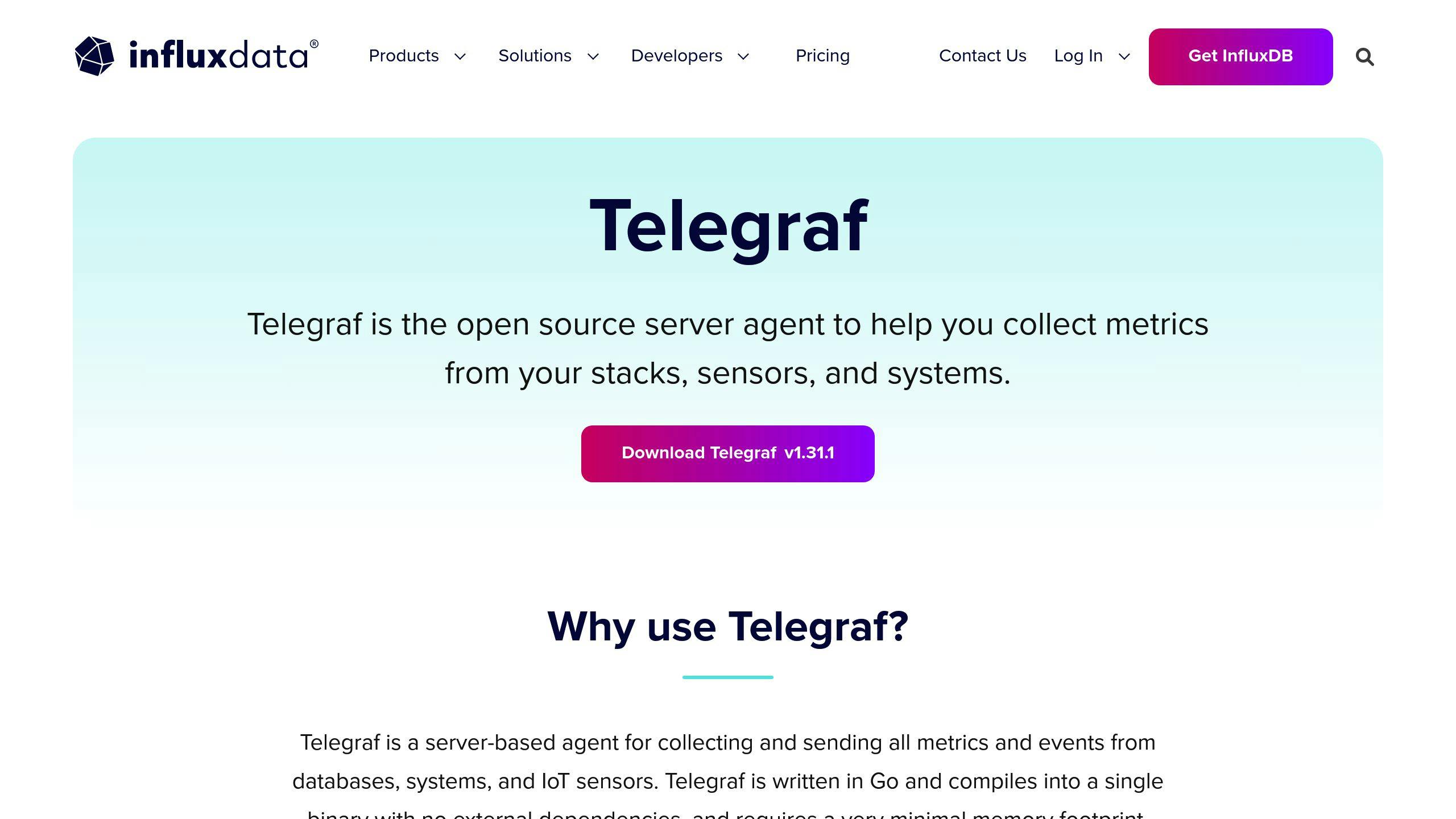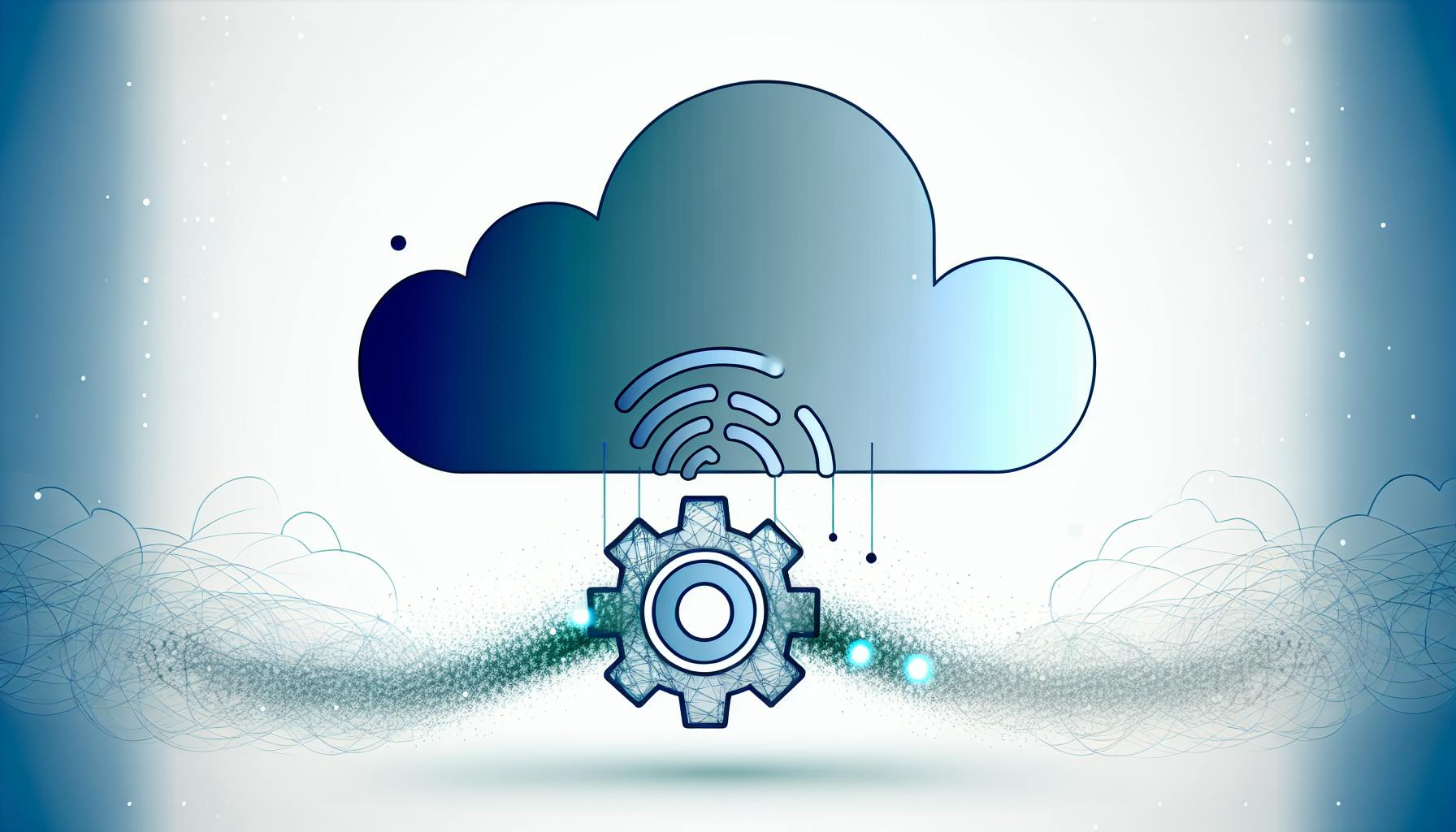Eyer Observability and Influx Telegraf work together to provide powerful IT system monitoring. Here's what you need to know:
- Eyer Observability: AI-powered system for monitoring IT infrastructure
- Influx Telegraf: Free tool that collects data from various sources
Key benefits:
- Quick problem-solving
- Efficient resource use
- Smooth operations
- Data-driven decision making
Telegraf's main functions:
- Collecting data from multiple sources
- Supporting various communication protocols
- Data transformation
- Sending data to different destinations
- Scalability
Setting up Telegraf involves:
- Installing the software
- Configuring input and output plugins
- Starting the Telegraf service
| Metric Type | Examples |
|---|---|
| System | CPU, memory, disk I/O |
| Applications | Response times, errors |
| Databases | Query speed, connections |
| Infrastructure | Server health, containers |
Advanced features include:
- Setting up alerts
- Automated responses to issues
- AI-powered monitoring
By using Eyer Observability with Influx Telegraf, companies can improve their IT monitoring, leading to better system performance and faster problem resolution.
Related video from YouTube
Basics of Eyer Observability

Main ideas and rules
Eyer Observability gives a full view of complex IT systems. It helps find and fix issues quickly by collecting and analyzing data in real-time. Unlike regular monitoring, it looks at more data to show how the whole system is working.
The main rules of Eyer Observability are:
- Always collect data from all parts of the system
- Look at the data right away
- Find possible problems early
- Focus on understanding why things happen in the system
Main parts
Eyer Observability has three main parts:
| Part | What it does |
|---|---|
| Logs | Keep detailed records of system events |
| Metrics | Measure how well the system is working |
| Traces | Follow requests through the whole system |
These parts work together to show how the system is doing. This helps teams fix complex problems and make the system work better.
Why use Eyer Observability
Using Eyer Observability helps in many ways:
| Benefit | How it helps |
|---|---|
| Find problems early | Spots issues before they become big problems |
| Fix issues faster | Gives more information about why things go wrong |
| Make systems work better | Shows how to improve system performance |
| Keep users happy | Fixes problems quickly for a better user experience |
| Make smart choices | Uses up-to-date information to guide decisions |
Getting to know Influx Telegraf

What Influx Telegraf does
Telegraf is a free tool made by InfluxData. It collects data about how systems are working and sends it to InfluxDB. This helps keep an eye on servers and other IT equipment. Telegraf can gather information from many places and send it to different spots, making it very useful for watching over systems.
Main functions
Telegraf's main jobs are:
-
Collecting data: Telegraf can get information from many sources:
Source Examples Sensors Pressure, temperature IT tools GitHub, Kubernetes System info iptables, Netstat - Using different ways to talk: It can use MQTT, ModBus, and OPC-UA to get data.
- Changing data: Telegraf can fix up data before saving it, using things like regex and Python.
- Sending data to many places: It can send data to different spots, but mostly to InfluxDB.
- Growing with your needs: You can use one Telegraf or many, depending on what you need.
How it helps Eyer Observability
Telegraf makes Eyer Observability better in these ways:
- Gets data from everywhere: By collecting info from many places, Telegraf helps see the whole system.
- Watches things right now: Telegraf keeps getting and sending data, so you can see what's happening now.
- Can change data as needed: It can fix up the data to make it more useful for watching the system.
- Works for big and small setups: Telegraf can handle small or big systems, so Eyer Observability works well for any size.
- Works well with time-based data: It fits nicely with InfluxDB, which is good for storing and looking at data over time.
Setting up Influx Telegraf
What you need before starting
Before setting up Influx Telegraf, make sure you have:
| Item | Description |
|---|---|
| Operating system | Ubuntu, Debian, or CentOS |
| System access | Admin rights |
| InfluxDB | Installed and set up |
| InfluxDB details | Organization name and bucket info |
| InfluxDB API token | With read/write permissions |
How to install: step-by-step
1. Add the InfluxData repository
For Debian-based systems:
curl -sL https://repos.influxdata.com/influxdata-archive_compat.key | sudo apt-key add -
source /etc/os-release
echo "deb https://repos.influxdata.com/debian $(lsb_release -cs) stable" | sudo tee /etc/apt/sources.list.d/influxdb.list
2. Install Telegraf
For Debian-based systems:
sudo apt-get update
sudo apt-get install telegraf
For CentOS/RHEL:
sudo yum install telegraf
3. Set up Telegraf
Make the default config file:
telegraf config > telegraf.conf
Change the config file:
sudo vi /etc/telegraf/telegraf.conf
Use this basic setup:
[agent]
interval = "10s"
round_interval = true
metric_batch_size = 1000
metric_buffer_limit = 10000
collection_jitter = "0s"
flush_interval = "10s"
flush_jitter = "0s"
precision = ""
hostname = ""
omit_hostname = false
[[outputs.influxdb_v2]]
urls = ["http://127.0.0.1:8086"]
token = "YOUR_INFLUXDB_TOKEN"
organization = "YOUR_ORG_NAME"
bucket = "telegraf"
[[inputs.cpu]]
percpu = true
totalcpu = true
collect_cpu_time = false
report_active = false
[[inputs.disk]]
ignore_fs = ["tmpfs", "devtmpfs", "devfs", "iso9660", "overlay", "aufs", "squashfs"]
[[inputs.diskio]]
[[inputs.mem]]
[[inputs.net]]
[[inputs.processes]]
[[inputs.swap]]
[[inputs.system]]
4. Start Telegraf
sudo service telegraf start
Tips for smooth setup
| Tip | How to do it |
|---|---|
| Back up your config | cp telegraf.conf telegraf.conf.bak |
| Use InfluxDB UI | Make Telegraf config through InfluxDB UI |
| Check connection | sudo tail -f /var/log/telegraf/telegraf.log |
| Start simple | Begin with basic system metrics |
| Keep updated | sudo apt-get update && sudo apt-get upgrade telegraf |
Important measurements and data gathering
Key things to measure
When using Influx Telegraf for monitoring, focus on these key metrics:
| Metric Type | What to Measure |
|---|---|
| System | CPU use, memory, disk I/O, network traffic |
| Apps | Response times, errors, request counts |
| Databases | Query speed, connections, cache hits |
| Infrastructure | Server health, containers, cloud resources |
Tracking these metrics helps you see how well your system is working and fix problems quickly.
How to set up data collection
To collect data with Telegraf:
- Pick what you want to watch
- Choose the right Telegraf plugins
- Set up input plugins in the config file
- Set up the InfluxDB output plugin
- Choose how often to collect data
Here's a simple example for system metrics:
[[inputs.cpu]]
percpu = true
totalcpu = true
[[inputs.mem]]
[[inputs.disk]]
ignore_fs = ["tmpfs", "devtmpfs"]
[[outputs.influxdb_v2]]
urls = ["http://localhost:8086"]
token = "YOUR_INFLUXDB_TOKEN"
organization = "YOUR_ORG"
bucket = "telegraf"
Adjusting data inputs and outputs
You can change Telegraf's settings to fit your needs:
- Change input plugins to get only the data you want
- Use processor plugins to clean up data before sending it
- Send data to more than one place at once
- Change settings without restarting Telegraf
Here's how to adjust CPU input and rename a field:
[[inputs.cpu]]
percpu = false
totalcpu = true
collect_cpu_time = false
[[processors.rename]]
[[processors.rename.replace]]
field = "usage_system"
dest = "system_usage"
Showing and understanding data
Tools to show data
Grafana is a free tool that works well with InfluxDB and Telegraf. It helps you see your data in easy-to-understand pictures. With Grafana, you can:
- Make custom screens to show your data
- Look at your data right away
- See information from different places all in one spot
Grafana is easy to change, so you can focus on the numbers that matter most to you. It works great with Eyer Observability and Influx Telegraf.
Understanding numbers and patterns
To make sense of the data from Telegraf and InfluxDB, try these steps:
- Pick the most important numbers for your system
- Know what's normal for your system
- Look for changes over time
- See how different parts of your system affect each other
By looking at these patterns, you can learn a lot about how well your system is working. For example, you might see that when the CPU works harder, the network gets busier too.
Making useful decisions from data
Using what you learn from your data is key to making good choices. Here's how to use your data:
| What to do | How it helps |
|---|---|
| Set up warnings | Fix problems before they get big |
| Look at old data | Plan for future needs |
| Find ways to improve | Make your system work better |
| Watch changes closely | See how updates affect your system |
sbb-itb-9890dba
Advanced monitoring methods
Setting up alerts
To catch problems early, you need good alerts. Here's how to set them up:
- Write a Flux query to define alert conditions
- Turn the query into a task for ongoing checks
- Make a dashboard to see task results
- Create a check based on specific limits
- Set up where to send alerts (like email or Slack)
- Make rules for when and how to send alerts
This helps you spot issues before they become big problems.
Automatic responses to issues
Kapacitor can work with Telegraf and InfluxDB to fix issues without human help. Here's what it does:
| Feature | What it does |
|---|---|
| Checks data | Looks at incoming info right away |
| Finds odd patterns | Spots unusual things or when limits are passed |
| Takes action | Runs scripts or commands to fix issues |
| Makes changes | Updates system settings based on what it finds |
This quick action can fix problems before users notice them.
Using AI for better monitoring
AI can make monitoring even better when used with Telegraf and InfluxDB. It helps by:
- Finding unusual things more accurately by learning what's normal
- Suggesting when to do maintenance based on past data
- Finding the cause of complex problems on its own
- Changing alert limits to avoid false alarms
Using AI can help keep things running smoothly and reduce downtime. As AI gets better, it will become even more useful for advanced monitoring.
Growing and improving Eyer Observability
As Eyer Observability systems get bigger and handle more data, it's important to focus on making them work well for large setups, run smoothly, and fix problems easily. Let's look at ways to manage big systems, make them work better, and solve common issues.
Managing big setups
When dealing with lots of data and complex systems:
- Use more than one Telegraf: Set up several Telegraf instances to spread out the work.
- Collect data less often: Change how often Telegraf collects data to reduce strain on your system.
- Process data in bigger chunks: Increase the
metric_batch_sizein Telegraf to handle more data at once.
Making it work better
To help your Eyer Observability setup run smoothly:
| What to do | How it helps |
|---|---|
| Set limits on resources | Keeps Telegraf from using too much CPU or memory |
| Collect data less often | Reduces strain on your system |
| Clean up Telegraf settings | Removes unnecessary parts to make things run faster |
Fixing common problems
When you run into issues with your Eyer Observability setup:
- Turn on debug mode: This gives you more information about what's happening.
- Look at log files: Check /var/log/syslog on Linux for error messages.
- Check your settings: Make sure all your config files are set up right.
- Watch resource use: Keep an eye on how much CPU and memory Telegraf is using.
| Problem | What to check |
|---|---|
| Telegraf not working | Debug mode, log files |
| System running slow | Resource use, data collection frequency |
| Missing data | Config files, input plugins |
Keeping data safe and following rules
When using Eyer Observability and Influx Telegraf for monitoring, it's important to keep data safe and follow the rules. This part looks at how to protect private information, follow industry rules, and monitor safely.
Protecting private information
To keep private information safe:
- Use strong encryption for data
- Only collect needed data
- Control who can see the data
- Check who looks at sensitive data and when
Following industry rules
It's important to follow the rules for your industry:
| Rule | What to do |
|---|---|
| GDPR | Collect less data, get permission, let people delete their data |
| HIPAA | Use encryption, control access, keep records of who sees data |
| PCI DSS | Separate networks, fix weak spots, check security often |
Tips for safe monitoring
To monitor safely:
- Use secure ways to send data
- Keep software up-to-date
- Use strong passwords and two-step login
- Check for security problems often
- Remove personal info from data when possible
What's next for IT monitoring
IT monitoring is changing fast. New tools and ways of working are coming. Let's look at what's new and how to get ready.
New tools and methods
IT systems are getting more complex. Monitoring tools are changing to keep up:
- Open-source tools: By 2025, half of new cloud app monitoring will use open-source tools instead of company-made ones. This means more choices and easier use.
- Seeing everything at once: New tools will show all parts of IT systems together. This helps find problems faster.
- Smart computers: AI and machine learning will help spot issues before they happen. They'll also fix some problems on their own.
Future of Eyer Observability
Eyer Observability is getting ready for these changes:
- Using open-source: Eyer will work with open-source tools to do more.
- Smarter insights: Eyer will use AI to find patterns and issues faster.
- Looking at more: Eyer will watch not just apps, but whole business systems.
Getting ready for new challenges
To be ready for new ways of monitoring, companies should:
| Challenge | What to do |
|---|---|
| Too many tools | Use one main tool instead of many |
| Too much data | Use smart computers to find what's important |
| Cloud issues | Use tools made for the cloud |
| Keeping things safe | Add safety checks to monitoring |
| Learning new skills | Train workers to use new tools |
Wrap-up
Main points to remember
- Telegraf has over 200 plugins to collect data from many sources, making it good for watching complex IT systems.
- Using Telegraf with InfluxDB helps find problems quickly and use resources better.
- Telegraf is easy to use and works well with InfluxDB, making it a good choice for companies that want to watch their systems closely.
How this helps IT in the long run
| Benefit | How it helps |
|---|---|
| Works for big systems | You can use Telegraf on each piece of hardware, making it more reliable and easier to update. |
| Saves money | Good monitoring helps find hardware that's not being used fully, which can save money. |
| Fixes problems faster | With full system watching, IT teams can fix outages more quickly. |
| Makes changes safer | Seeing everything in the system helps network teams make changes with less worry. |
Final thoughts on Eyer Observability
Eyer Observability, using Influx Telegraf, is a big step forward in IT monitoring. It helps companies see how their systems are working in detail. This is important because it lets them:
- Collect and look at lots of data quickly
- Understand complex IT setups better
- Keep systems working well
As IT keeps changing, tools like Eyer will become more important. Using these advanced monitoring tools can help companies:
- Stay quick and efficient
- Be ready for new IT challenges
FAQs
Why use Telegraf with InfluxDB?

Telegraf and InfluxDB work well together for watching IT systems. Here's why:
| Reason | How it helps |
|---|---|
| Easy to use together | Telegraf sends data straight to InfluxDB without problems |
| Many ways to get data | Telegraf can collect info from over 300 different places |
| Easy to change | You can set up Telegraf to fit what you need |
| Handles data well | Telegraf can clean up data before sending it to InfluxDB |
| Keeps data safe | Telegraf makes sure all the data gets to InfluxDB |
These tools help companies keep an eye on their IT systems without much trouble. They work for small and big setups, making it easier to spot and fix problems quickly.



